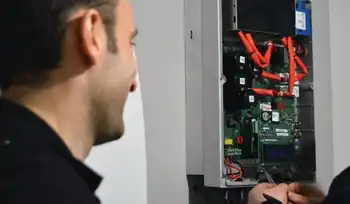Solution to stricken reactors still coming
TOKYO, JAPAN - The operator of JapanÂ’s crippled nuclear plant said it was still working on a detailed plan to end the countryÂ’s nuclear crisis a month after it began, as tests showed radiation levels in the sea near the complex had spiked.
Engineers moved a step closer to emptying highly radioactive water from one of the six crippled reactors, which would allow them to start repairing the cooling system crucial to regaining control of the reactors.
JapanÂ’s nuclear safety agency said the latest tests showed radiation nearly doubled last week, to 23 times above legal limits, in the sea off Minamisoma city near the plant.
Radiation in Tokyo, 240 km 150 miles from the plant, had fallen to pre-disaster levels, the science ministry said.
A series of strong aftershocks has rattled eastern Japan, slowing the recovery effort at the Fukushima Daiichi plant due to temporary evacuations of workers and power outages.
The beleaguered president of operator Tokyo Electric Power Co TEPCO said the situation at the nuclear plant, wrecked by a 15-metre tsunami on March 11, had stabilized.
But TEPCO president Masataka Shimizu said the firm was still preparing a blueprint to end the crisis, now rated on a par with the worldÂ’s worst nuclear accident, the 1986 Chernobyl disaster.
“As instructed by Prime Minister Kan we are working out the specific details of how to handle the situation so they can be disclosed as soon as possible,” a relaxed-looking Shimizu told a news conference in Tokyo.
Shimizu has been largely absent from the recovery operation, spending time in hospital and only visiting the area. He refused to comment on public calls for his resignation, and again apologised to the Japanese people for the crisis.
“We are making the utmost effort to bring the reactors at Fukushima Daiichi to a cold shutdown and halt the spread of radiation,” he said.
TEPCOÂ’s Tokyo head office has been the target of angry protests over the nuclear crisis and authorities took no chances, with riot trucks and security officers guarding the front gate during the news conference.
Latest data shows much more radiation leaked from the Daiichi plant in the early days of the crisis than first thought, prompting officials to rate it on a par with the Chernobyl disaster.
But experts were quick to point out the two crises were vastly different in terms of radiation contamination, and RussiaÂ’s nuclear chief said Japan was exaggerating the scope of the disaster.
“It is hard for me to assess why the Japanese colleagues have taken this decision. I suspect, this is more of a financial issue, than a nuclear one,” Sergei Kiriyenko said on the sidelines of a meeting of major economies in southern China.
There have been fears of contamination among JapanÂ’s neighbours, but China said the impact there had been small, noting the radiation was just 1 percent of what it had experienced from Chernobyl.
The toll of the disaster is rising. More than 13,000 people have been confirmed dead, and the government cut its outlook for the economy, in deflation for almost 15 years, for the first time in six months.
“The biggest risks, or uncertain factors for the economy, are when power supplies will recover, whether the nuclear situation will keep from worsening,” Economics Minister Kaoru Yosano said.
The total cost of the triple catastrophe has been estimated at $300 billion, making it the worldÂ’s most costly natural disaster. TEPCO said it was working on a compensation plan.
The Yomiuri newspaper reported that the government may cap TEPCOÂ’s liability to as little as $24 billion for damages. Bank of America-Merrill Lynch has estimated compensation claims of more than $130 billion.
Radiation readings in seawater near the crippled plant spiked, JapanÂ’s Nuclear and Industrial Safety Agency NISA said.
Seawater samples collected from around 15 km 9 miles off the coast of Minamisoma city showed radiation in the water rose to 23 times the legal limit from 9.3 times on April 7, said Hidehiko Nishiyama, a NISA deputy director-general.
He later said NISA had asked TEPCO to assess the quake resistance of the buildings, and to look into how they could be reinforced against aftershocks.
“We need to think about how these aftershocks are affecting the buildings, which are already damaged,” he said.
Japan has expanded the 20 km 12 miles evacuation zone around the plant because of high accumulated radiation.
No radiation-linked deaths have been reported and only 21 plant workers have been affected by minor radiation sickness.
Still, the increase in the severity level heightens the risk of diplomatic tension with Japan’s neighbours over radioactive fallout. Chinese Premier Wen Jiabao told Kan he was “concerned” about the release of radiation into the ocean.
“Its impact on our country’s environment has been small, equivalent to about 1 percent of the impact of the Chernobyl nuclear accident on our country,” China’s nuclear safety body said.
“There is no need to adopt protective measures.”
Related News

French Price-Fixing Probe: Schneider, Legrand, Rexel, and Sonepar Fined
PARIS - In a significant crackdown on corporate malfeasance, French authorities have imposed hefty fines on four major electrical equipment companies—Schneider Electric, Legrand, Rexel, and Sonepar—after concluding a price-fixing investigation. The total fines amount to approximately €500 million, underscoring the seriousness with which regulators are addressing anti-competitive practices in the electrical distribution sector.
Background of the Investigation
The probe, initiated by France’s Competition Authority, sought to uncover collusion among these leading firms regarding the pricing of electrical equipment and services between 2005 and 2012. This investigation is part of a broader initiative to promote fair competition within the market, ensuring…




